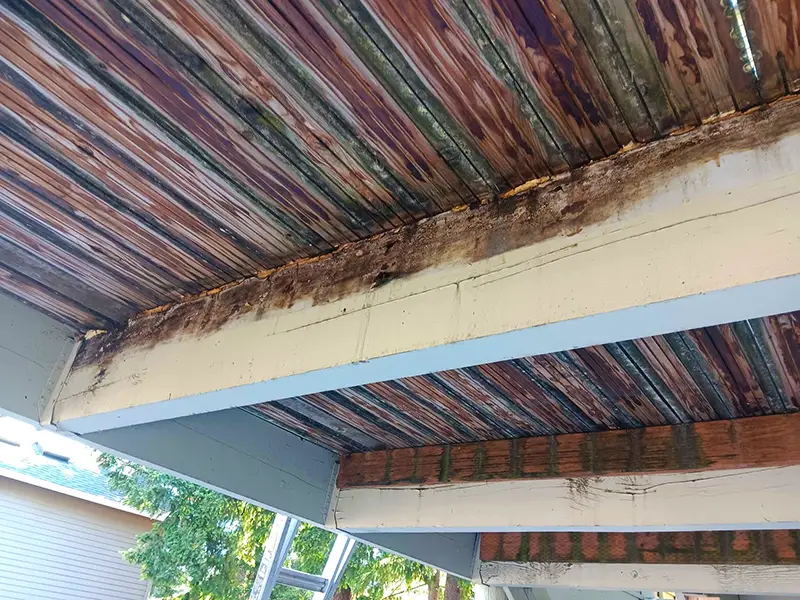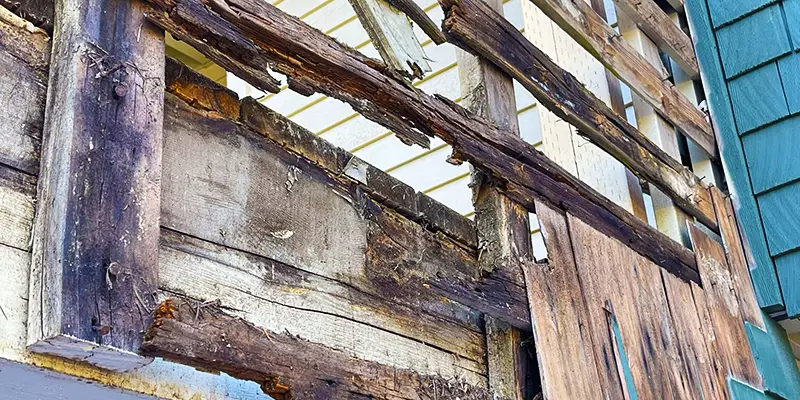2-Minute Read
06/24/2024
Expert Insight
Rot Repair Essentials
Dry rot is a silent adversary that can cause considerable damage to wooden structures in homes. Detecting it early is crucial for maintaining the integrity and safety of your property. This article will guide you through the steps to identify dry rot, helping you spot potential problems before they become serious. By learning to recognize the signs of dry rot, you can take timely action to address this issue and protect your home.
Understanding Rot
Dry rot is a type of fungal decay that targets wood, breaking it down and causing severe damage. The fungus responsible, Serpula lacrymans, thrives in moist conditions and can destroy the wood from inside out without noticeable external signs at first. It is different from other types of rot because it can transport moisture from wet areas to dry, allowing it to spread even in less obviously damp environments.
Why Rot Is Dangerous
Dry rot is particularly concerning because it can weaken structural elements of your home, such as joists, beams, and flooring. Left unchecked, it can lead to costly repairs and pose safety risks.
Ideal Conditions for Growth
The fungus starts growing when wood’s moisture content rises above 20%. Common contributors to these conditions include leaking pipes, poor drainage, or inadequate ventilation. Recognizing environments conducive to dry rot is a crucial step in preventing its occurrence.
What Does Rot Look Like?
Identifying dry rot early can prevent severe damage to your home. Here are the key signs to watch for, which will help you spot this destructive issue before it worsens.
One of the first indications of dry rot is wood that appears cracked or is crumbling. If you notice that touching the wood causes it to break apart easily, this could be a sign of advanced decay.
Additionally, discoloration such as unusual staining or darkening of the wood often signals moisture damage, which dry rot needs to thrive. Another clear sign is the presence of fruiting bodies that resemble mushrooms. These pancake-like growths on wood surfaces indicate that the rot has reached a mature stage and is reproducing. You might also see mycelium, which looks like white or gray cotton-like sheets spreading across wood surfaces. This is the fungal growth feeding off the wood.
What Does Rot Feel Like
Feeling the wood can also provide clues about dry rot. Wood affected by dry rot often feels spongy or soft when pressed with a tool. This softness indicates that the wood’s internal structure is compromised. Additionally, if the wood is unusually brittle and pieces break off easily, this is another telltale sign of dry rot. This can also make the wood like it is crumbling or turning into dust.
Does Dry Rot Have A Smell
A damp, musty odor is often present in areas affected by dry rot. This smell can be a helpful indicator, especially for detecting hidden rot within walls or beneath floors where visual signs might not be immediately apparent.
Common Areas of Your Home To Check for Rot
Dry rot can occur in many parts of a home, but it’s most commonly found in areas where moisture tends to accumulate. Regularly inspecting these areas can help you catch dry rot before it becomes a larger issue. Here are key areas to keep an eye on:
Window Sills and Frames
Windows, especially in older homes, are prone to dry rot because they are frequently exposed to moisture from condensation and rain. Check the sills and frames for any signs of softness, discoloration, or fungal growth.
Door Frames and Entryways
Like windows, door frames are vulnerable to water infiltration, particularly at the bottom where rainwater can collect. Examine these areas for any changes in texture or appearance that might suggest moisture damage.
Decking and Outdoor Wooden Structures
Outdoor wood structures are constantly exposed to the elements, making them likely candidates for dry rot. Inspect the decking boards, especially those that are in contact with the ground or near planters, as soil moisture can contribute to decay.

Roofing and Attic Spaces
Leaks in the roof can lead to dry rot in the attic, where it can damage beams and joists. Check your attic regularly for any signs of leakage or wood damage, particularly after heavy rainfall.
Basements and Crawl Spaces
These lower areas of your home are often damp and poorly ventilated, ideal conditions for dry rot to flourish. Look for signs of rot around wooden beams and posts, as well as near any plumbing that could leak and contribute to moisture levels.
Plumbing Penetrations
Areas around pipes and plumbing fixtures can also be ideal spots for dry rot. This is because leaking fixtures provide the necessary moisture for rot to develop. Pay special attention to the wood surrounding pipes, particularly in kitchens and bathrooms.
By keeping a vigilant eye on these common areas, you can detect dry rot early and mitigate its impact on your home. Ensuring good ventilation and addressing leaks promptly are key strategies in preventing dry rot from taking hold.
Tools and Techniques for Detecting Dry Rot
Detecting dry rot early is crucial for maintaining the structural integrity of your home. While visual inspections are helpful, there are tools and techniques that can provide a more thorough assessment, especially in areas that are not easily accessible or visibly apparent. Here’s how you can use these tools to ensure your home is free from dry rot:
Moisture Meter
A moisture meter is an essential tool for detecting areas of high moisture content where dry rot could potentially develop. By measuring the moisture levels in wood and other building materials, you can identify problematic areas that need further inspection or immediate action. Use this tool around known trouble spots like window frames, bathrooms, and below sinks.
Screwdriver
For a hands-on approach, a simple screwdriver or an awl can be used to test the integrity of the wood. Gently press the tool into the wood surface at suspect areas. If the tool sinks into the wood easily, it may indicate that the wood has become soft and potentially affected by dry rot.
Smartphone
Using a smartphone can be helpful during inspections to document the conditions of areas at risk for dry rot. These images can be useful for comparison over time to see if the condition worsens or improves after repairs and treatments. Additionally, photos are an excellent resource for rot repair contractors. They can generally assess photos to determine if your home is infected with dry rot.
Stay Ahead of Rot in Your Home
Recognizing the signs of dry rot and knowing where to look are crucial first steps in protecting your home from this destructive condition. Regular inspections using the right tools and techniques are essential to catch dry rot before it leads to serious damage. Remember, early detection is key to preventing the spread and minimizing the impact of dry rot on your home.
Maintain vigilance in areas prone to moisture and ensure your home has adequate ventilation to keep wood dry. If you do discover signs of dry rot, taking immediate action by consulting a professional can save you from extensive and costly repairs in the future. Protect your home by staying informed and proactive against the threat of dry rot.
Best Dry Rot Repair Contractor
Dry rot damage is a big concern for homeowners. Protect your home by understanding the signs of dry rot and working with a contractor to repair and prevent further damage. We’ve worked hard to earn our reputation as the best dry rot damage repair contractor in the area. We would love the opportunity to demonstrate our skills. Whether a job is big or small—give us a chance to make you our next satisfied customer!
With nearly 20 years of experience and thousands of satisfied customers, you can trust SFW Construction has the skills and knowledge to repair your home.
If you need to repair dry rot —contact us today for a free consultation.


